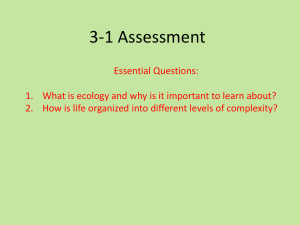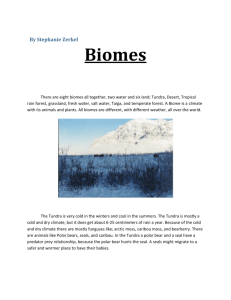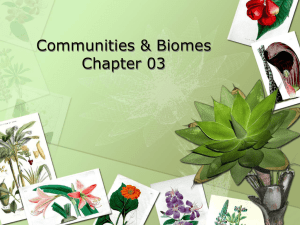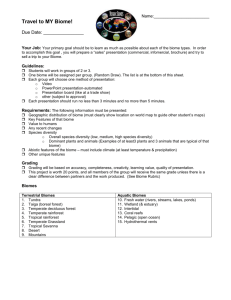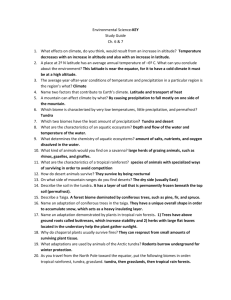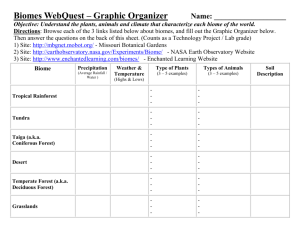ES CH 6 Study Guide 2015 with essay KEY
advertisement
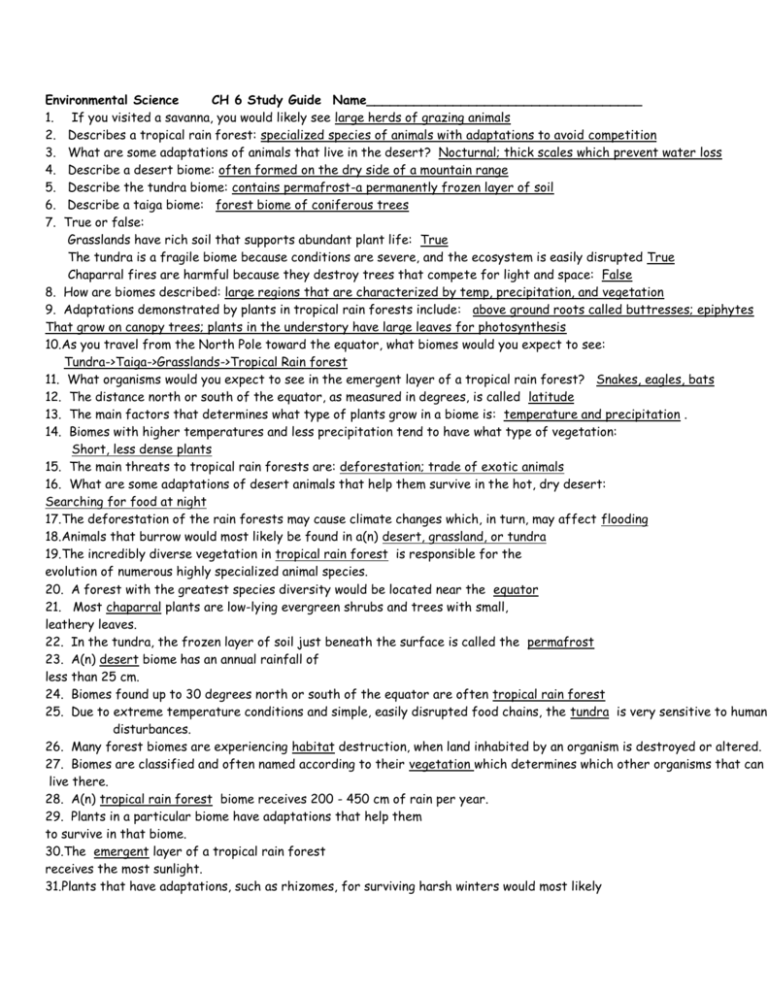
Environmental Science CH 6 Study Guide Name___________________________________ 1. If you visited a savanna, you would likely see large herds of grazing animals 2. Describes a tropical rain forest: specialized species of animals with adaptations to avoid competition 3. What are some adaptations of animals that live in the desert? Nocturnal; thick scales which prevent water loss 4. Describe a desert biome: often formed on the dry side of a mountain range 5. Describe the tundra biome: contains permafrost-a permanently frozen layer of soil 6. Describe a taiga biome: forest biome of coniferous trees 7. True or false: Grasslands have rich soil that supports abundant plant life: True The tundra is a fragile biome because conditions are severe, and the ecosystem is easily disrupted True Chaparral fires are harmful because they destroy trees that compete for light and space: False 8. How are biomes described: large regions that are characterized by temp, precipitation, and vegetation 9. Adaptations demonstrated by plants in tropical rain forests include: above ground roots called buttresses; epiphytes That grow on canopy trees; plants in the understory have large leaves for photosynthesis 10.As you travel from the North Pole toward the equator, what biomes would you expect to see: Tundra->Taiga->Grasslands->Tropical Rain forest 11. What organisms would you expect to see in the emergent layer of a tropical rain forest? Snakes, eagles, bats 12. The distance north or south of the equator, as measured in degrees, is called latitude 13. The main factors that determines what type of plants grow in a biome is: temperature and precipitation . 14. Biomes with higher temperatures and less precipitation tend to have what type of vegetation: Short, less dense plants 15. The main threats to tropical rain forests are: deforestation; trade of exotic animals 16. What are some adaptations of desert animals that help them survive in the hot, dry desert: Searching for food at night 17.The deforestation of the rain forests may cause climate changes which, in turn, may affect flooding 18.Animals that burrow would most likely be found in a(n) desert, grassland, or tundra 19.The incredibly diverse vegetation in tropical rain forest is responsible for the evolution of numerous highly specialized animal species. 20. A forest with the greatest species diversity would be located near the equator 21. Most chaparral plants are low-lying evergreen shrubs and trees with small, leathery leaves. 22. In the tundra, the frozen layer of soil just beneath the surface is called the permafrost 23. A(n) desert biome has an annual rainfall of less than 25 cm. 24. Biomes found up to 30 degrees north or south of the equator are often tropical rain forest 25. Due to extreme temperature conditions and simple, easily disrupted food chains, the tundra is very sensitive to human disturbances. 26. Many forest biomes are experiencing habitat destruction, when land inhabited by an organism is destroyed or altered. 27. Biomes are classified and often named according to their vegetation which determines which other organisms that can live there. 28. A(n) tropical rain forest biome receives 200 - 450 cm of rain per year. 29. Plants in a particular biome have adaptations that help them to survive in that biome. 30.The emergent layer of a tropical rain forest receives the most sunlight. 31.Plants that have adaptations, such as rhizomes, for surviving harsh winters would most likely be found in a temperate deciduous forest. 32.During harsh winters, animals of the taiga have adaptations such as the ability to change color to avoid predators. 33. The climate of a biome is determined mostly by average temperature and precipitation. 34. Vegetation in biomes where water is scarce consists predominantly of short trees, shrubs, and grasses. 35. Tropical rain forest are being destroyed primarily by logging for lumber and to create open land for agriculture 36. Most of the animals in the tropical rain forest live in the canopy layer, where fruits and flowers are abundant. 37. Latitude is the distance north or south of the equator. 38. Altitude is the height above sea level. 39. The canopy consist of the tops of tall trees and epiphytes. 40. Logging, farming, and oil exploration are ways in which the tropical rain forest of the world are being threatened. 41. Oil exploration is a major threat to the tundra biome. 42. Climate refers to weather conditions in an area over a long period. 43. The understory is the layer below the canopy that has shorter trees and shrubs. 44. The temperate deciduous forest is a biome that is generally located 30 and 50 degrees north latitude and has extreme ranges in temperature. 45. A biome is a large region characterized by a specific climate, plants, and animals. 46. Migration of animals in the savanna is mostly in response to rainfall. 47. The two main factors that determine where organisms live are temperature and precipitation. Essay Question: Explain how climate determines the distinguishing characteristics of different biomes. Explain how temperature and precipitation are related to climate. Explain how climate determines what organisms will be in a particular biome. Climate is the weather conditions that exist in an area over a long period of time. These conditions, which include Temperature and precipitation, determine the type of plants that can survive in a biome, because plants prefer warm Temperatures and plenty of water. The plants, in turn, determine the animals that will live in that biome.

